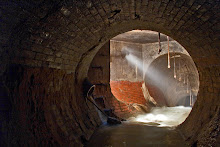My chosen passage follows the page break on pg 36 of the Picador edition with the line ‘Nicholas Temelcoff is famous on the bridge’ and ends with the next page break, ‘He knows his position in the air as if he is mercury slipping across a map.’
I have selected this passage because it is placed in the middle of the episode in which Temelcoff saves the nun on the bridge. This was my favourite episode in the book, and one which I felt was most memorable, but this passage in particular stands out because of the narrative shifts (Heble refers to this in the article in the course-pack pg 249, but in reference to another passage). Both passages before and after this extract are written in the past tense, but this shifts into the present, which has the effect of placing the reader closer to Temelcoff, giving the sense the we are there with him rather than simply being an observer from a distance. At the same time, however, there is a shift in perspective. The passages before and after are both written from Temelcoff’s perspective; although in the 3rd rather than 1st person, what is going on is seen through his eyes and we have his thoughts presented in a stream of consciousness. This excerpt, in contrast is written from the narrator’s point of view, which one would assume would distance the reader. I feel it does the opposite, possibly because of the how he is presented; the opening, ‘Nicholas Temelcoff is…’, takes the character from the novel and places him directly in front of the reader. It is followed by a list of facts, ‘He is given all the difficult jobs…He descends into the air…He is solitary’ (36), so we feel like we have more information about him, but none of it is personal. There is a strong contrast between the man presented from the interior through his own thoughts and the one presented from the exterior through the narrator, a contrast between private and personal history. What I suggest Ondaatje is trying to achieve are different views of the immigrant; to the nun, and us the readers who are privy to what has occurred, he is a strong, sensitive man, who seems to be struggling with the dislocation he feels, which is evident from connection he makes with her; to everyone on the outside, his employers, his colleagues, he is simply another worker, albeit one (like Patrick and his father) with an exceptionally risky job which ‘no one dreams of doing’ (37). In a sense, we feel closer to him because this passage presents him at a distance from everyone else. We know his interior.
Further to the fact that he is a ‘solitary’ (36) figure, who no one really knows, we are told that ‘even in archive photographs it is difficult to find him’ (36). This is the kind of thing that Heble highlights as evidence of ‘homogenizing practices in the production of Canadian history’ (241). If it is hard to see him in a photo, which is definite evidence of him being at the construction of the bridge, it would be even more difficult to hear his story when the only evidence is Temelcoff himself, unless he is able to pass it on to someone. At this point in the novel, he has no relationships, so no one to pass his story to, which is why, I suggest, he tries to make such a connection with the nun. We must remember that no one knows the nun has survived, there is no one except her to either pass on or corroborate the story (except, obviously, the narrator, who passes it onto the reader). Basically, Temelcoff as a person is overlooked, and as such, is omitted from the history of the making of the bridge.
I also thought that the final comment, ‘like mercury slipping across a map’ (38), links nicely in with what Heble says about ‘the “reality” constructed by maps’ (239), and the fact that Patrick’s hometown, ‘which did not appear on a map until 1910…the land had been homesteaded since 1816’ (11). In itself, it is an unusual image (do we consider Temelcoff to be volatile and able to separate into smaller parts of himself, or possibly a good alloy, attaching well to other elements?) , but is it suggesting that he does not really know where he is because the accuracy of the map depends upon who has envisioned it?

1 comment:
I like the way you’ve illustrated the ‘contrast between private and personal history’ through close analysis (the point of view from which Nicholas Temelcoff is presented – his own vs. an omniscient narrator’s). Both your post and David’s bring up the question of photographs, which are another kind of ‘text’, and one that is usually assumed to have more historical verity than a linguistic text. But Ondaatje is showing us how photos are themselves unreliable texts – the cyclist is a blur, and Temelcoff is hard to pick out of the archive photos. Yet another of Ondaatje’s pregnant images.
Nice exegesis, too, of the metaphor of mercury slipping across the map, and how it can be read in more than one way.
Post a Comment